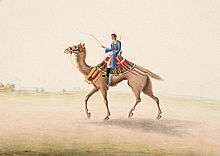Purbiyas (soldiers)
Purbiya (or Purabia) was a common term used in medieval India for Rajput-led mercenaries and soldiers from the eastern Gangetic Plain - areas corresponding to present-day western Bihar and eastern Uttar Pradesh.[1][2] The Purbiyas played a significant role in the militaries of various principalities in Western India including the Marwar army.[3]
Recruitment
The core region for Purbiya recruitment was the Bhojpur region of modern-day Western Bihar and Eastern Uttar Pradesh.[4] The Ujjainiya clan of Rajputs were the main territorial lords of this region and they played the role of specialised recruiting agents and commanders of these Purbiya soldiers who were usually young peasant men native to Bhojpur.[4] The soldiers gained a great reputation among the lords and kings of Northern and Western India and the Ujjainiyas used this to raise their status among other Rajput clans.[4]
Many future Purbiya mercenaries would carry out a pilgrimage to Buxar in modern-day Bihar where they would immerse themselves in a tiger tank. During this process, the young peasant would see themselves as being reborn as a "fearless warrior".[4]
History
The Mughals were among the first groups to enter into the military labour market and start recruiting Purbiyas. Mughal sources detail a diwan of Bihar subah attempting to collect soldiers in Buxar to serve the emperor.[5]
The rulers of Malwa were also keen recruiters due to Purbiyas' expertise with firearms. This expertise may have been gained due to the easy availability of saltpetre in their native areas.[6] Most Purbiyas were mercenaries and were paid for their services but some were actual kings of smaller principalities.[2][7] This recruitment drive from Malwa saw the large influx of Purbiya soldiers into the region. Many of the local chieftains in Malwa depended heavily on Purbiya soldiers such as Silhadi who eventually became known as a Purbiya himself.[5] The presence of Purbiya mercenaries in Gujarat are referenced in 16th and 17th century Persian chronicles including many Purbiya gunners serving in the army of Bahadur Shah of the Gujarat Sultanate in 1535.[8]
Purbiyas had a long tradition of being recruited as mercenaries for various rulers such as the British[9][10] and the Marathas.[1] Purbiyas made up the majority of the Bengal Army.[10]Prior to 1857, the British East India Company preferred to recruit Purbiya soldiers, who they designated as "The fighting tribes of the Hindoos and the Musselmen", or simply "Easterners".[11][12] The Bengal Army of the East India Company preferred to recruit its sepoys from the Brahmins and Rajputs of Awadh and Bihar, in part because they had an average height of 5'10", an important consideration in an army that valued impressive appearance amongst its soldiers.[13]
1857 mutiny
.jpg)
The Purbiya units of the Bengal Army played a major role in the Indian Rebellion of 1857 against the British. Mangal Pandey, a notable figure during the start of the mutiny, was a Purbiya serving in the 34th Bengal Native Infantry. Following the suppression of the uprising, British authorities decided not to recruit troops from the eastern plains, and the new Bengal Army was to be recruited primarily from the Sikh and Muslim communities of the Punjab.[14][15] Purbiya recruitment from the western regions of the United Provinces and the Delhi region continued but on a much smaller scale (two out of sixty-four regiments by 1893).[16]
See also
References
- Waltraud Ernst; Biswamoy Pati (18 October 2007). India's Princely States: People, Princes and Colonialism. Routledge. p. 57. ISBN 978-1-134-11988-2.
- M. S. Naravane (1999). The Rajputs of Rajputana: A Glimpse of Medieval Rajasthan. APH Publishing. p. 23. ISBN 978-81-7648-118-2.
- Deepak Solanki (2016). "THE ROLE OF NON-RAJPUTS IN EIGHTEENTH CENTURY MARWAR ARMY: AHERIS, PATHANS, PARDESIS, PURBIYAS, AND SWAMIS". Proceedings of the Indian History Congress. 77: 298–305. JSTOR 26552655.
- Dirk H.A. Kolff (2013). "Peasants fighting for a living in early modern North India". Fighting for a Living. Amsterdam University Press: 243–266. JSTOR j.ctt6wp6pg.11.
- Dirk H. A. Kolff (8 August 2002). Naukar, Rajput, and Sepoy: The Ethnohistory of the Military Labour Market of Hindustan, 1450-1850. Cambridge University Press. p. 59. ISBN 978-0-521-52305-9.
- Ernst, Waltraud; Pati, Biswamoy (2007). India's Princely States: People, Princes and Colonialism. Routledge. p. 57. ISBN 978-1-134-11988-2.
- Journal of Indian history, Volume 66, Dept. of History, University of Kerala, 1988
- Iqtidar Alam Khan (1999). "Re-examining the origin and group identity of the so-called "Purbias", 1500-1800". Proceedings of the Indian History Congress. 60: 363–371. JSTOR 44144102.
- Alf Hiltebeitel (15 February 2009). Rethinking India's Oral and Classical Epics: Draupadi among Rajputs, Muslims, and Dalits. University of Chicago Press. p. 308. ISBN 978-0-226-34055-5.
- Karsten, Peter (31 October 2013). Recruiting, Drafting, and Enlisting: Two Sides of the Raising of Military Forces. Routledge. p. 103. ISBN 978-1-135-66150-2.
- Roy, Kaushik; Lorge, Peter (17 December 2014). Chinese and Indian Warfare – From the Classical Age to 1870. p. 335. ISBN 9781317587101.
- Mason, Philip (1986). A Matter of Honour. pp. 229 & 573. ISBN 978-0-333-41837-6.
- Roy, Kaushik (2012). Hinduism and the Ethics of Warfare in South Asia: From Antiquity to the Present. p. 214. ISBN 9781107017368.
- Roy, Kaushik (6 October 2015). Military Manpower, Armies and Warfare in South Asia. p. 6. ISBN 9781317321286.
- Mason, Philip (1986). A Matter of Honour. p. 305. ISBN 978-0-333-41837-6.
- David, Saul (4 September 2003). The Indian Mutiny. p. 404. ISBN 978-0-141-00554-6.
Further reading
- M K A Siddiqui (ed.), Marginal Muslim Communities in India, Institute of Objective Studies, New Delhi (2004)
- Dasharatha Sharma Rajasthan through the Ages a comprehensive and authentic history of Rajasthan, prepared under the orders of the Government of Rajasthan. First published 1966 by Rajasthan Archives.
